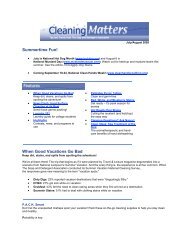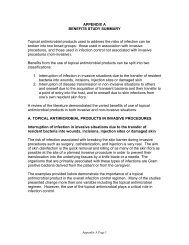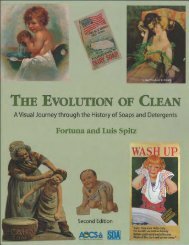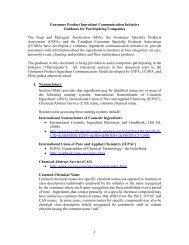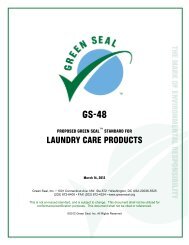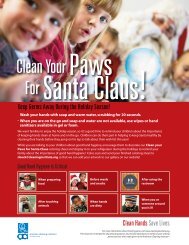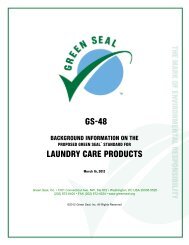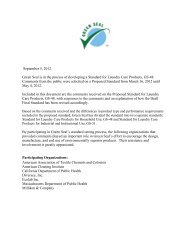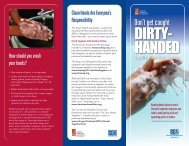subchapter c -- federal hazardous substances act regulations
subchapter c -- federal hazardous substances act regulations
subchapter c -- federal hazardous substances act regulations
You also want an ePaper? Increase the reach of your titles
YUMPU automatically turns print PDFs into web optimized ePapers that Google loves.
temperature. Advance the knob clockwise to<br />
the next numbered line. After the thermometer<br />
mercury column ceases to advance, read the<br />
dial reading and the temperature. Repeat this<br />
procedure through the full range of the<br />
instrument. Plot the dial readings versus the<br />
respective temperatures.<br />
(2) Standardize the instrument using a<br />
sample of material meeting the specifications<br />
in table 1. If the average of two determinations<br />
falls within the acceptable limits the<br />
instrument is assumed to be operating<br />
properly. If the average of the two<br />
determinations does not fall within this range,<br />
check the manuf<strong>act</strong>urer’s operating and<br />
maintenance instructions and determine that<br />
they are being followed. In particular, be sure<br />
that the cup lid assembly makes a vapor-tight<br />
seal with the cup, the shutter provides a lighttight<br />
seal, and that adequate heat transfer paste<br />
surrounds the thermometer bulb and the<br />
immersed portion of the barrel.<br />
(i) Test Method A — for determining<br />
Flash/No Flash.<br />
(1) Determine the target flashpoint as<br />
follows:<br />
(i) Target flashpoint, °C=S c —0.25<br />
(101.3—A)<br />
(ii) Target flashpoint, °C=S c —0.03<br />
(760–B)<br />
(iii) Target flashpoint, °F=S f —0.06<br />
(760–B)<br />
where:<br />
S c = specification, or uncorrected target,<br />
flashpoint, °C,<br />
S f = specification, or uncorrected target,<br />
flashpoint, °F,<br />
B = ambient barometric pressure, mm Hg, 5<br />
and<br />
A=ambient barometer pressure, kPa.<br />
(2) Inspect the inside of the sample cup,<br />
lid, and shutter mechanism for cleaniness and<br />
freedom from contamination. Use an<br />
absorbent paper tissue to wipe clean, if<br />
necessary. Put cover in place and lock<br />
5 The barometric pressure used in this calculation<br />
must be the ambient pressure for the laboratory at<br />
the time of test. Many aneroid barometers, such as<br />
those used at weather stations and airports, are<br />
precorrected to give sea-level readings; these must<br />
not be used.<br />
16 CFR Ch. II (1–1–05 Edition)—proposed modificication – 6/25/06<br />
-- 43 --<br />
securely. The filing orifice may be<br />
convenienty cleaned with a pipe cleaner.<br />
(3) Set the instrument at the target<br />
temperature.<br />
(i) For target temperature below ambient.<br />
The instrument power switch is to be in the off<br />
position. Fill the refigerant-charged cooling<br />
block with a suitable material. 6 Raise the lid<br />
and shutter assembly, and position the base of<br />
the block in the sample cup, being careful not<br />
to injure or mar the cup. When the<br />
thermometer reads approximately 6 to 10 °C<br />
(10 to 20 °F) below the target temperature,<br />
remove the cooling block and quickly dry the<br />
cup with a paper tissue to remove any<br />
moisture. Immediately close the lid and<br />
shutter assembly and secure. Prepare to<br />
introduce the sample using the syringe, both of<br />
which have been precooled to a temperature 5<br />
to 10 °C (10 to 20 °F) below the target<br />
temperature.<br />
(A) Caution: Do not cool the sample block<br />
below — 38 °C, the freezing point of mercury.<br />
(B) Caution: Acetone is extremely<br />
flammable. Keep away from heat, sparks, and<br />
flames and keep container closed when not<br />
<strong>act</strong>ually pouring acetone. Use only in a wellventilated<br />
area. Avoid inhalation and cont<strong>act</strong><br />
with the eyes or skin. Use cloth or leather<br />
gloves, goggles or safety shield, and keep dry<br />
ice in a canvas bag, especially when cracking.<br />
(ii) For target temperature above ambient.<br />
Switch the instrument on and turn the coarse<br />
temperature control knob fully clockwise (full<br />
on) causing the indicator light to illuminate. 7<br />
When the thermometer indicates a temperature<br />
about 3 °C (5 °F) below the target (or<br />
6 If the target or specification temperature is not<br />
less than 5 °C (40 °F) crushed ice and water may<br />
be used as charging (cooling) fluid. If below 5 °C<br />
(40 °F), a suitable charging (cooling) fluid is solid<br />
carbon dioxide (dry ice) and acetone. If the<br />
refrigerant charged cooling module is unavailable,<br />
refer to the manuf<strong>act</strong>urer’s instruction manual for<br />
alternative methods of cooling.<br />
7 The target temperature may be attained by<br />
originally turning the coarse temperature control<br />
knob to the proper setting (see § 1500.43a(h)(1) for<br />
the temperature desired rather than the maximum<br />
setting (full on). The elapsed time to reach the<br />
temperature will be greater, except for maximum<br />
temperature. However, less attention will be<br />
required during the intervening period.



